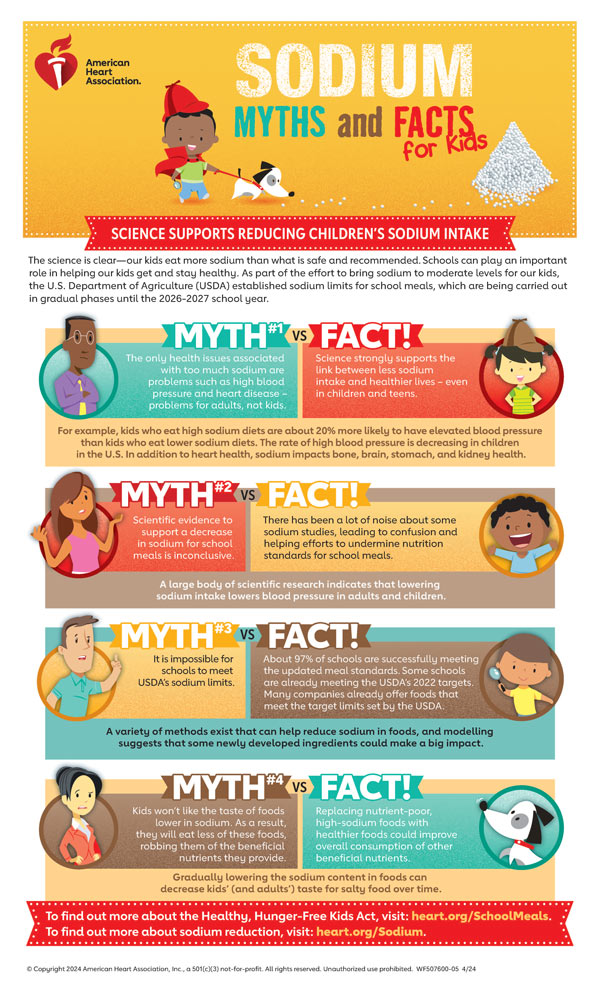Sodium Myths and Facts for Kids Infographic

Science Supports Reducing Children’s Sodium Intakes.
The science is clear... our kids eat more sodium than what is safe and recommended. Schools can play an important role in helping our kids get and stay healthy. As part of the effort to bring sodium to moderate levels for our kids, the U.S. Department of Agriculture (USDA) established sodium limits for school meals, which are being carried out in three gradual phases until the 2022-2023 school year.
Myth #1
The only health issues associated with too much sodium are problems like high blood pressure and heart disease – problems for adults, not kids.
Fact #1
Science strongly supports the link between less sodium intake and healthier lives – even in children and teens.
For example, kids who eat high sodium diets are about 35% more likely to have elevated blood pressure than kids who eat lower sodium diets. And, the rate of high blood pressure is increasing in American children. In addition to heart health, sodium impacts bone, brain, stomach, and kidney health.
Myth #2
Scientific evidence to support a decrease in sodium for school meals is inconclusive.
Fact #2
There has been a lot of noise about some sodium studies, leading to confusion and helping efforts to undermine nutrition standards for school meals.
A large body of scientific research indicates that lowering sodium intake lowers blood pressure in adults and children.
Myth #3
It is impossible for schools to meet USDA’s sodium limits.
Fact #3
Actually, more than 99 percent of schools are successfully meeting the updated meal standards. Some schools are already meeting the USDA’s 2017 targets. Many companies already offer foods that meet the target limits set by the USDA.
A variety of methods exist that can help reduce sodium in foods , and modelling suggests that some newly developed ingredients could make a big impact.
Myth #4
Kids won’t like the taste of foods lower in sodium and, as a result, will eat less of these foods, robbing them of the beneficial nutrients they provide.
Fact #4
Replacing nutrient-poor, high-sodium foods with healthier foods could improve overall consumption of other beneficial nutrients.
Gradually lowering the sodium content in foods can decrease kids’ (and adults’) taste for salty food over time.
To find out more about the Healthy, Hunger-Free Kids Act, visit: heart.org/schoolmeals
To find out more about sodium reduction, visit: heart.org/sodium
Last reviewed January 2017.
1Institute of Medicine (IOM). 2004. Dietary Reference Intakes for Water, Potassium, Sodium, Chloride, and Sulfate. Washington, DC: The National Academies Press.
2U.S. Department of Agriculture, Agricultural Research Service.2012.Nutrient Intakes from Food: Mean Amounts Consumed per Individual, by Gender and Age, What We Eat in America, NHANES 2009-2010. Available: www.ars.usda.gov/ba/bhnrc/fsrg.
3USDA. Final Rule “Nutrition Standards in the National School Lunch and School Breakfast Programs (1/26/12).” Accessed online 8/14/15 at: https://www.fns.usda.gov/sites/default/files/cn/SFAcert_FY16Q4.pdf
4Appel et al. Reducing Sodium Intake in Children: A Public Health Investment. Journal of Clinical Hypertension. 2015:1–6.
5Rosner et al. Childhood blood pressure trends and risk factors for high blood pressure: The NHANES experience 1998-2008. Hypertension. 2013;62:247-254.
6Lloyd-Jones et al. Defining and Setting National Goals for Cardiovascular Health Promotion and Disease Reduction: The American Heart Association’s Strategic Impact Goal through 2020 and Beyond. Circulation. 2010 Feb 2;121(4):586-613.
7Appel et al. The importance of population-wide sodium reduction as a means to prevent cardiovascular disease and stroke: A call to action from the American Heart Association. Circulation. 2011, 15;123(10):1138-43.
8Whelton et al. Sodium, blood pressure, and cardiovascular disease: Further evidence supporting the American Heart Association sodium reduction recommendations. Circulation. 2012;126:2880-2889 4/14/2015
9Statement from Secretary Vilsack on New Data Showing the Vast Majority of Schools Now Meet the Updated Meals Standards. USDA. May 6, 2015. Accessed online at http://www.fns.usda.gov/school-meals/school-meal-certification-data
10National Alliance for Nutrition and Activity. Mission: Possible Companies Can Meet USDA’s New Sodium Limits for School Meals. Accessed online 8/14/2014: http://cspinet.org/new/pdf/NANA%20 Sodium%20products%20that%20meet%20new%20guidelines%20oct%2014.pdf
11Antman et al. Stakeholder discussion to reduce population-wide sodium intake and decrease sodium in the food supply: A conference report from the American Heart Association sodium conference 2013 planning group. Circulation. 2014.
12Agarwal et al. Sodium Intake Status in United States and Potential Reduction Modeling: an NHANES 2007-2010 analysis. Food Science and Nutrition. 2015. DOI: 10.1002/ fsn3.248
13IOM. 2010. Strategies to Reduce Sodium Intake in the United States. Washington, DC: The National Academies Press

